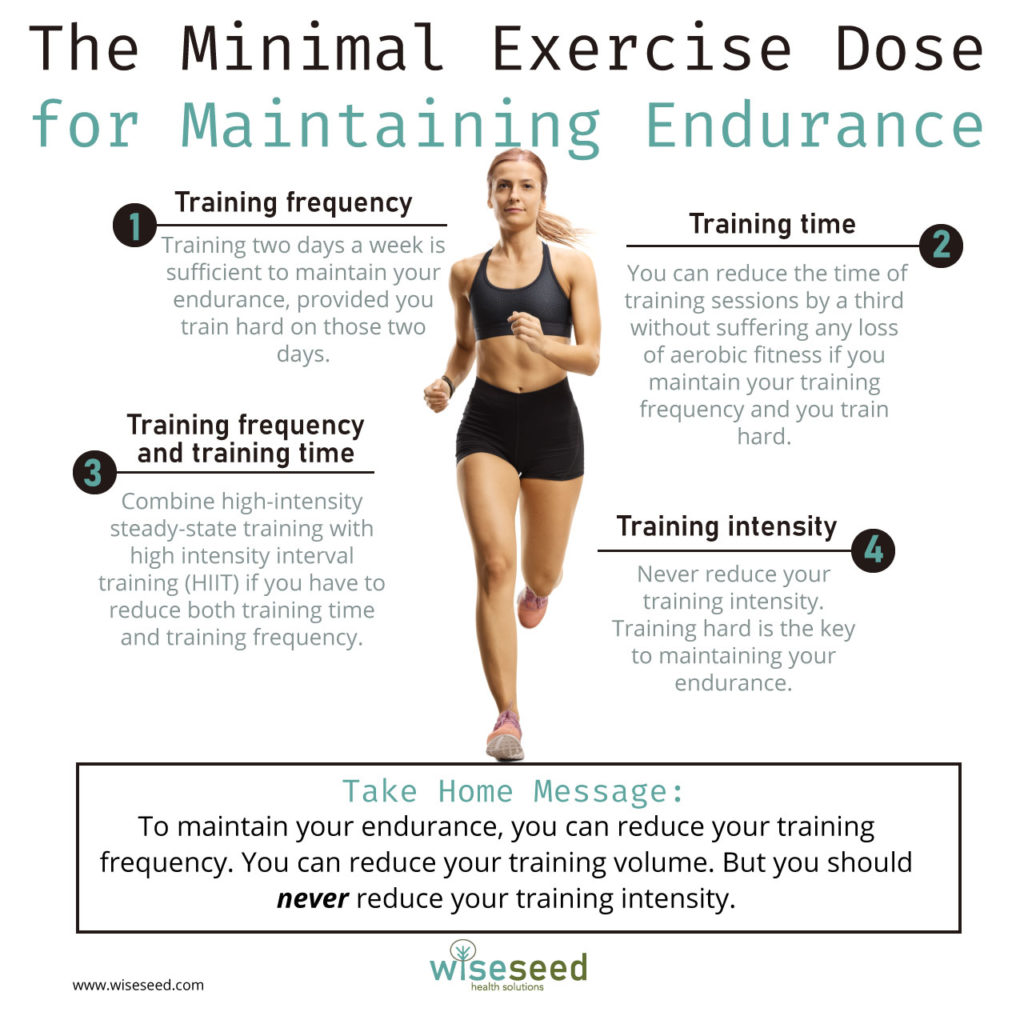The Minimal Dose of Exercise to Maintain Endurance

Sometimes, life gets in the way.
We all know that getting into shape is hard work! However, life often gets in the way of training. Career, family commitments, or simply wanting to switch training gears for awhile can force you to take a break from your current training program. The worst part of this scenario is that you usually detrain and lose many of the fitness gains that you worked so hard to achieve. This really sucks!
But fear not! A recent study by Spiering and Colleagues 1 has distilled the minimum dose of exercise that is required for you to maintain your physical fitness. You can use this knowledge to stay in shape while you re-focus your efforts on other important aspects of your life.
Frequency, volume and intensity.
Before we dive into the study, it is important to first define the key variables of interest: frequency, volume and intensity.
Frequency refers to the number of weekly training sessions that you devote to endurance training. Volume refers to the amount of time you spend training for each session, not including warm-ups and cool-downs. Finally, intensity refers to how hard you exercised. For endurance training, your intensity is usually expressed as a percent of your maximal work capacity. For example, if you performed a 10 km run at 80% of your maximal heart rate, your intensity would be 80% of HRmax.
How the studies were performed.
The studies analysed by Spiering and Colleagues 1 all followed the same basic format. Healthy adults were trained at a sufficiently high intensity, frequency and volume to increase their aerobic fitness. Their fitness levels were assessed, and the group was then divided up into smaller groups that trained at lower intensities, volumes and frequencies for an extended period. Finally, the participants had their fitness tested again, and the scores between the two tests were compared to judge the effectiveness (or lack thereof) of the different maintenance training approaches tested.
Reducing training frequency.
For those of you who are forced to reduce the number of days per week that you can train, good news! Training only two days a week is sufficient to maintain your endurance and aerobic fitness 1. However, for this approach to work, you have to train hard and you must keep your volume the same.
This means that your training intensity should be at least 80%, but preferably 90%, of your maximum. Further, if you usually train for 60 minutes, then the duration of your two workouts should be at least 60 minutes long.
Reducing training volume.
The Author’s found that people could reduce their total time training by 33% without suffering any loss in endurance1. The caveat is that you must maintain your frequency , as well as train at a high intensity to preserve your current fitness levels.
Reducing both training frequency and training volume.
Unfortunately, the Author’s make no recommendation for this scenario. My suggestion is that you combine high-intensity steady-state with high intensity interval training (HIIT).
I’ve spoken about HIIT before. HIIT is successfully used by athletes to maintain aerobic fitness during the off season 2. If you pick your exercises correctly, you can do 20 minutes of high-intensity steady-state cardio (e.g. running) followed by a 5 minute HIIT session (e.g. a heavy bag Tabata workout). That’s 25 minutes of high-quality work right there!
Reducing training intensity.
Reducing training intensity does not work! For example, people who trained 6 times per week at 61–67% of their HRmax lost most of their fitness 1! The inescapable conclusion is that reducing training intensity is a terrible strategy for maintaining fitness. Don’t do it!
Often, you are forced to reduce your training intensity due to injury. However, continuing to train at a lower intensity exposes you to further injury and doesn’t even keep you in shape! Instead, I recommend that you find exercises that you can safely perform at high intensities, and do those instead.
Take Home Message.
The good news is that you can maintain your aerobic fitness despite the ebbs and flows of life. You can reduce your training frequency. You can reduce your training volume. But never reduce your training intensity.
Please click on the link to downlaod your free pdf.

References and Further Reading
1 Spiering, B. A., Mujika, I., Sharp, M. A. & Foulis, S. A. Maintaining Physical Performance: The Minimal Dose of Exercise Needed to Preserve Endurance and Strength Over Time. J Strength Cond Res, doi:10.1519/jsc.0000000000003964 (2021).
2 Slettaløkken, G. & Rønnestad, B. R. High-intensity interval training every second week maintains VO2max in soccer players during off-season. J Strength Cond Res 28, 1946-1951, doi:10.1519/jsc.0000000000000356 (2014).
Disclaimer
The material displayed on this website is provided without any guarantees, conditions or warranties as to its accuracy.
Information written and expressed on this website is for education purposes and interest only. It is not intended to replace advice from your medical or healthcare professional.
You are encouraged to make your own health care choices based on your own research and in conjunction with your qualified practitioner.
The information provided on this website is not intended to provide a diagnosis, treatment or cure for any diseases. You should seek medical attention before undertaking any diet, exercise, other health program or other procedure described on this website.
To the fullest extent permitted by law we hereby expressly exclude all warranties and other terms which might otherwise be implied by statute, common law or the law of equity and must not be liable for any damages whatsoever, including but without limitation to any direct, indirect, special, consequential, punitive or incidental damages, or damages for loss of use, profits, data or other intangibles, damage to goodwill or reputation, injury or death, or the cost of procurement of substitute goods and services, arising out of or related to the use, inability to use, performance or failures of this website or any linked sites and any materials or information posted on those sites, irrespective of whether such damages were foreseeable or arise in contract, tort, equity, restitution, by statute, at common law or otherwise.

Ten Minutes is All You Need
Research has shown that ten minutes of moderate-to-vigorous exercise performed each day is enough to significantly reduce your risk of early death.

How to Sprint Safely
Healthy adults can sprint safely if they build a strong aerobic and strength base, strengthen their hamstring and calf muscles, and apply a sub-maximal approach to sprint training.




